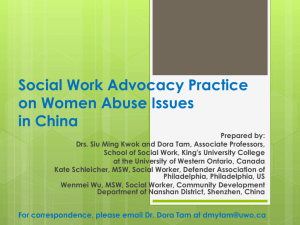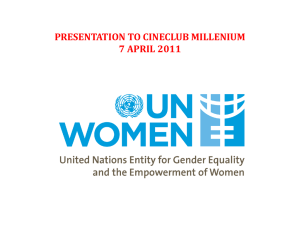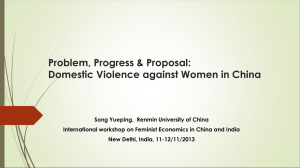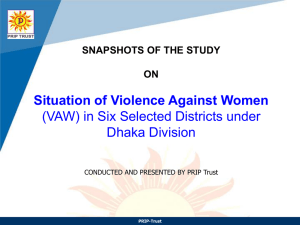Violence Against Women in Nepal: Services and Needs Assessment
advertisement
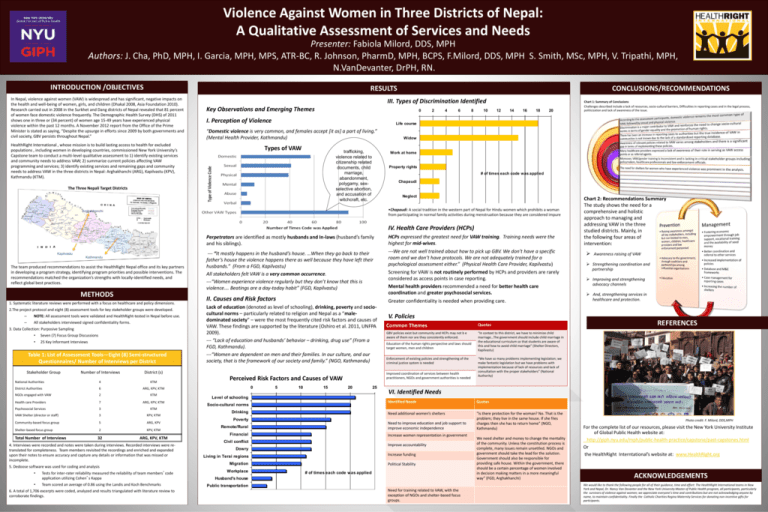
Violence Against Women in Three Districts of Nepal: A Qualitative Assessment of Services and Needs Presenter: Fabiola Milord, DDS, MPH Authors: J. Cha, PhD, MPH, I. Garcia, MPH, MPS, ATR-BC, R. Johnson, PharmD, MPH, BCPS, F.Milord, DDS, MPH S. Smith, MSc, MPH, V. Tripathi, MPH, N.VanDevanter, DrPH, RN. INTRODUCTION /OBJECTIVES RESULTS In Nepal, violence against women (VAW) is widespread and has significant, negative impacts on the health and well-being of women, girls, and children (Dhakal 2008, Asia Foundation 2010). Research carried out in 2008 in the Surkhet and Dang districts of Nepal revealed that 81 percent of women face domestic violence frequently. The Demographic Health Survey (DHS) of 2011 shows one in three or (34 percent) of women age 15-49 years have experienced physical violence within the past 12 months. A November 2012 report from the Office of the Prime Minister is stated as saying, “Despite the upsurge in efforts since 2009 by both governments and civil society, GBV persists throughout Nepal.” CONCLUSIONS/RECOMMENDATIONS III. Types of Discrimination Identified Key Observations and Emerging Themes 0 I. Perception of Violence 4 6 8 10 12 14 16 18 20 Life course “Domestic violence is very common, and females accept [it as] a part of living.” (Mental Health Provider, Kathmandu) HealthRight International , whose mission is to build lasting access to health for excluded populations , including women in developing countries, commissioned New York University’s Capstone team to conduct a multi-level qualitative assessment to 1) identify existing services and community needs to address VAW; 2) summarize current policies affecting VAW programming and services; 3) identify existing services and remaining gaps and community needs to address VAW in the three districts in Nepal: Arghakhanchi (ARG), Kapilvastu (KPV), Kathmandu (KTM). 2 Types of VAW trafficking, violence related to citizenship related documents, child marriage, abandonment, polygamy, sexselective abortion, and accusation of witchcraft, etc. The Three Nepali Target Districts Widow Work at home Property rights # of times each code was applied Chapaudi Neglect •Chapaudi: A social tradition in the western part of Nepal for Hindu women which prohibits a woman from participating in normal family activities during menstruation because they are considered impure Arghakhanchi IV. Health Care Providers (HCPs) Kapilvastu Kathmandu The team produced recommendations to assist the HealthRight Nepal office and its key partners in developing a program strategy, identifying program priorities and possible interventions. The recommendations matched the organization’s strengths with locally-identified needs, and reflect global best practices. METHODS 1. Systematic literature reviews were performed with a focus on healthcare and policy dimensions. 2.The project protocol and eight (8) assessment tools for key stakeholder groups were developed. – NOTE: All assessment tools were validated and HealthRight-tested in Nepal before use. – All stakeholders interviewed signed confidentiality forms. 3. Data Collection: Purposive Sampling • Seven (7) Focus Group Discussions • 25 Key Informant Interviews Table 1: List of Assessment Tools—Eight (8) Semi-structured Questionnaires/ Number of Interviews per District Stakeholder Group Number of Interviews District (s) National Authorities 4 KTM District Authorities 6 ARG, KPV, KTM NGOs engaged with VAW 2 KTM Health care Providers 7 ARG, KPV, KTM Psychosocial Services 3 KTM VAW Shelter (director or staff) 3 KPV, KTM Community-based focus group 5 ARG, KPV Shelter-based focus group 2 KPV, KTM 32 ARG, KPV, KTM Total Number of Interviews 4. Interviews were recorded and notes were taken during interviews. Recorded interviews were retranslated for completeness. Team members revisited the recordings and enriched and expanded upon their notes to ensure accuracy and capture any details or information that was missed or incomplete. 5. Dedoose software was used for coding and analysis • • Tests for inter-rater reliability measured the reliability of team members’code application utilizing Cohen’s Kappa Team scored an average of 0.86 using the Landis and Koch Benchmarks 6. A total of 1,706 excerpts were coded, analyzed and results triangulated with literature review to corroborate findings. Perpetrators are identified as mostly husbands and In-laws (husband’s family and his siblings). HCPs expressed the greatest need for VAW training. Training needs were the highest for mid-wives. --- “It mostly happens in the husband’s house. …When they go back to their father’s house the violence happens there as well because they have left their husbands.” (From a FGD, Kapilvastu) All stakeholders felt VAW is a very common occurrence. ---“Women experience violence regularly but they don’t know that this is violence.… Beatings are a day-today habit” (FGD, Kapilvastu) ---We are not well trained about how to pick up GBV. We don’t have a specific room and we don’t have protocols. We are not adequately trained for a psychological assessment either.” (Physical Health Care Provider, Kapilvastu) Screening for VAW is not routinely performed by HCPs and providers are rarely considered as access points in case reporting. Mental health providers recommended a need for better health care coordination and greater psychosocial services. II. Causes and Risk factors Greater confidentiality is needed when providing care. Lack of education (denoted as level of schooling), drinking, poverty and sociocultural norms – particularly related to religion and Nepal as a “maledominated society” – were the most frequently cited risk factors and causes of VAW. These findings are supported by the literature (Oshiro et al. 2011, UNFPA 2009). --- “Lack of education and husbands’ behavior – drinking, drug use” (From a FGD, Kathmandu). ---“Women are dependent on men and their families. In our culture, and our society, that is the framework of our society and family.” (NGO, Kathmandu) 5 10 15 V. Policies Common Themes Quotes GBV policies exist but community and HCPs may not b e aware of them nor are they consistently enforced. “In context to this district, we have to minimize child marriage…The government should include child marriage in the educational curriculum so that students are aware of this and how to avoid child marriage” (Shelter Directors, Kapilvastu) Education of the human rights perspective and laws should target women, men and children Enforcement of existing policies and strengthening of the criminal justice system is needed Improved coordination of services between health practitioners, NGOs and government authorities is needed Perceived Risk Factors and Causes of VAW 0 Chart 1: Summary of Conclusions Challenges described include a lack of resources, socio-cultural barriers, Difficulties in reporting cases and in the legal process, politicization and lack of awareness of the issue. 20 25 Chart 2: Recommendations Summary The study shows the need for a comprehensive and holistic approach to managing and addressing VAW in the three studied districts. Mainly, in the following four areas of intervention: Awareness raising of VAW Strengthening coordination and partnership Improving and strengthening advocacy channels And, strengthening services in healthcare and protection. REFERENCES “We have so many problems implementing legislation; we make fantastic legislation but we have problems with implementation because of lack of resources and lack of consultation with the proper stakeholders” (National Authority) VI. Identified Needs Level of schooling Socio-cultural norms Drinking Poverty Identified Needs Quotes Need additional women’s shelters “Is there protection for the woman? No. That is the problem; they live in the same house. If she files charges then she has to return home” (NGO, Kathmandu) Remote/Rural Need to improve education and job support to improve economic independence Financial Increase women representation in government Civil conflict Improve accountability Dowry Living in Terai regions Increase funding Migration Political Stability Workplace # of times each code was applied Husband's house Public transportation Need for training related to VAW, with the exception of NGOs and shelter-based focus groups. We need shelter and money to change the mentality of the community. Unless the constitution process is complete, many issues remain unsettled. NGOs and government should take the lead for the solution. Government should also be responsible for providing safe house. Within the government, there should be a certain percentage of women involved in decision making matters in a more meaningful way” (FGD, Arghakhanchi) Photo credit: F. Milord, DDS,MPH For the complete list of our resources, please visit the New York University Institute of Global Public Health website at: http://giph.nyu.edu/mph/public-health-practice/capstone/past-capstones.html Or the HealthRight Interntational’s website at: www.HealthRight.org ACKNOWLEDGEMENTS We would like to thank the following people for all of their guidance, time and effort: The HealthRight International teams in New York and Nepal, Dr. Nancy Van Devanter and the New York University Master of Public Health program, all participants, particularly the survivors of violence against women; we appreciate everyone’s time and contributions but are not acknowledging anyone by name, to maintain confidentiality. Finally the Catholic Charities Regina Maternity Services for donating non-incentive gifts for participants.
